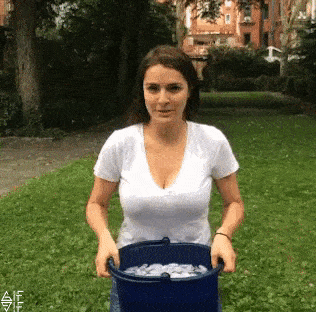
A decade ago, a simple yet daring challenge swept across the globe, captivating the hearts of millions. It was the “Ice Bucket Challenge” that poured icy buckets of water on participants and flooded social media feeds. It was more than just a viral sensation; it was a movement that aimed to raise awareness and funds for amyotrophic lateral sclerosis (ALS), also known as Lou Gehrig’s disease. Now, as we reflect on this extraordinary campaign, it’s time to ask ourselves: Did the “Ice Bucket Challenge” actually make a lasting impact? Let’s dive into the depths of this icy phenomenon and uncover its true legacy:
1. The Birth of a Social Media Storm:
Like a gust of icy wind, the “Ice Bucket Challenge” blew across the internet, catching everyone off guard. It started as a humble act of support by Pete Frates, an ALS patient, who challenged friends and family to take the plunge. Little did he know that his call to action would unleash an unprecedented wave of global solidarity. What began as a grassroots movement rapidly gained momentum, thanks to the power of social media. People from all corners of the world picked up the challenge, filming themselves getting drenched and sharing their videos with hashtags like #IceBucketChallenge and #StrikeOutALS. The campaign spread like wildfire, reaching millions and transforming into a phenomenon that transcended borders and brought people together in an extraordinary way.
2. The Power of Unity:
The “Ice Bucket Challenge” united people from all walks of life, transcending borders, cultures, and social backgrounds. From Hollywood celebrities to everyday individuals, everyone wanted to be part of this unique movement. Social media platforms were ablaze with videos of people bravely enduring the frigid deluge, all in the name of raising awareness for ALS. The challenge not only drew attention to the disease but also fostered a sense of community, as participants nominated their friends and family to take part. People took pride in joining the cause and contributing to a larger purpose. It was a powerful reminder that together, we have the ability to drive change and make a difference in the lives of those who are affected by devastating diseases like ALS.
3. A Cascade of Donations:
One of the defining aspects of the “Ice Bucket Challenge” was its ability to translate online trends into tangible impact. As the challenge spread like wildfire, so did the donations pouring into ALS research. In just a few months, the ALS Association witnessed an astounding surge in contributions, amounting to a staggering $115 million. These funds opened doors to groundbreaking research, leading to a deeper understanding of the disease and advancements in treatment options. The “Ice Bucket Challenge” proved that a simple act, amplified by the power of social media, could translate into a significant financial boost for a cause. It showed the world that viral trends can go beyond fleeting moments of entertainment and generate substantial resources to tackle pressing issues.
4. Shining a Spotlight on ALS:
Before the “Ice Bucket Challenge,” ALS was a relatively unknown condition to the majority of the world. But as icy water cascaded down countless individuals’ heads, so did a newfound awareness of this debilitating disease. The campaign served as a powerful platform to educate millions, empowering them to become advocates for change and inspiring compassion for those affected by ALS. The challenge put a face to the disease, sharing stories of ALS patients and their families, shedding light on the struggles they faced daily. It humanized the condition, evoking empathy and sparking conversations that were long overdue. Through the “Ice Bucket Challenge,” ALS became a household name, and discussions about the disease reached communities that had previously been unaware of its existence.
5. Driving Scientific Breakthroughs:
The massive influx of funding spurred a wave of research breakthroughs in the field of ALS. Scientists were able to accelerate their studies, exploring potential treatments and uncovering vital genetic markers. Thanks to the “Ice Bucket Challenge,” there is now more hope than ever for finding a cure for this devastating disease. Researchers have made significant strides in understanding the underlying mechanisms of ALS, identifying promising targets for therapeutic interventions, and developing potential treatments that could potentially slow the progression of the disease.
While there is still much work to be done, the “Ice Bucket Challenge” played a crucial role in propelling ALS research forward and bringing us closer to the day when a cure will be within reach. A decade has passed since the “Ice Bucket Challenge” captured our attention, but its legacy remains etched in the annals of social media history. From viral sensation to catalyst for change, this remarkable campaign accomplished more than anyone could have anticipated. Not only did it raise unprecedented funds for ALS research, but it also created a lasting awareness of the disease worldwide.
The “Ice Bucket Challenge” proved that a viral trend could transcend screens and make a genuine impact on society. It taught us the power of unity, compassion, and the incredible possibilities that arise when we come together for a common cause.
So, the next time you see a throwback video from 2014, remember the immense ripple effect it created, and let it inspire you to continue making a difference in the world, one icy bucket at a time. Remember: Challenges may come and go, but the spirit of compassion and the quest for a cure will forever remain.
The “Ice Bucket Challenge” exemplified the extraordinary potential of harnessing the collective power of social media to create real change. It ignited a global movement, united people from all walks of life, generated substantial donations, raised awareness about ALS, and accelerated scientific breakthroughs. It serves as a reminder that even the smallest acts of kindness, amplified by the internet, can have an everlasting impact on the lives of countless individuals.